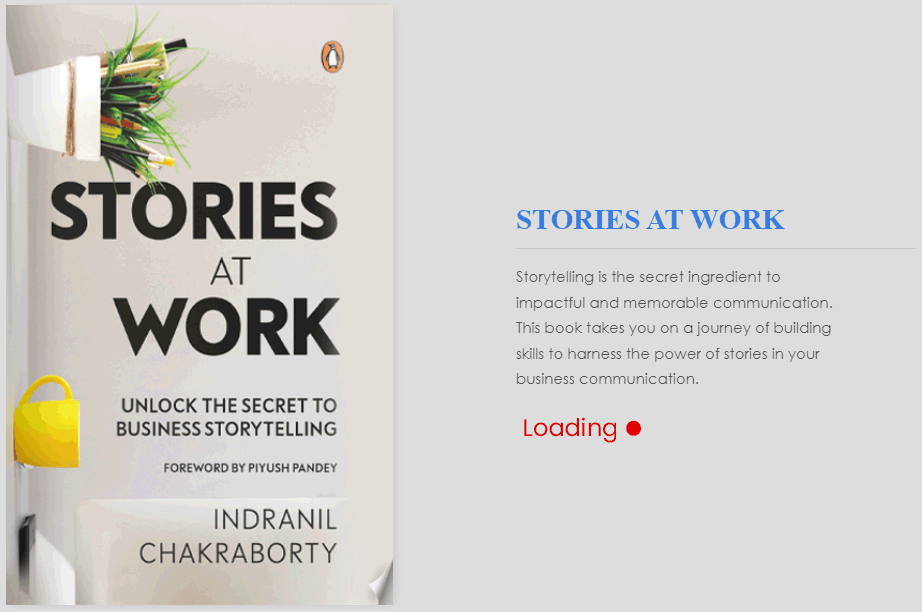STORIES AT WORK
Storytelling is the secret ingredient to impactful and memorable communication. This book takes you on a journey of building skills to harness the power of stories in your business communication.
Storytelling is the secret ingredient to impactful and memorable communication. This book takes you on a journey of building skills to harness the power of stories in your business communication.
Is there a way to send out impactful messages that people remember for days?
Is there a way to influence people without pushing data and analysis on them?
Is there an effective way to drive change in an organization?
Yes, through stories.
Storytelling in business is different from telling stories to friends in a bar. It needs to be based on facts. Stories at Work will teach you how to wrap your stories in context and deliver them in a way that grabs your audience’s attention.
The special tools, techniques, and structures in this book will help you bring the power of stories into your day-to-day business communication. They will enable you to connect, engage and inspire, and ensure that everything you share has a lasting impression on your listeners.


Foreword | xi |
Prologue | xv |
Acknowledgements | xxi |
Introduction: The Art of Gathering Gold Dust | xxiii |
Part I: Foundation
| |
1. Stories Are Powerful—Evolution and
Biology Have a Role to Play | 3 |
2. Why Stories? | 14 |
3. How to Build Your Story Bank | 32 |
4. Telling, Listening to, and Triggering Stories | 39 |
Part II: Different Story Patterns | |
5. Using Stories to Build Rapport and Credibility | 49 |
6. Using Stories to Influence and Overcome Objections | 66 |
7. Getting Strategies to Stick | 76 |
8. Writing Case Studies That Are Understood,
Remembered and Can Be Retold | 91 |
9. Story Listening | 99 |
Part III: Putting Them Together
| |
10. Getting Values to Be Understood,
Remembered and Put into Action | 109 |
11. Understanding Complex Human Issues
by Listening to Stories | 123 |
12. Other Powerful Uses of Story Listening | 131 |
13. Managing Change through Stories | 142 |
14. Storytelling for the Super Salesman | 153 |
15. Presentation and Storytelling | 161 |
16. Storytelling with Data | 178 |
17. Ethics and the Power of Stories | 194 |
18. Building a Sustainable Storytelling
Organization | 201 |
19. Going Forward | 208 |
The Art of Gathering Gold Dust
It was hot and dusty, a typical summer’s day in a small town in Uttar Pradesh. As a young sales manager at Hindustan Unilever, I was on my mandatory market visit. Today was the wholesale beat. Most of the wholesalers were working on a wafer-thin margin. Their way of working seemed to defy everything I had learned at IIM (Indian Institute of Management) Ahmedabad. I sat on an empty oil tin, sipping a cup of tea made mostly of milk and sugar. I noticed a fifteen-year-old boy manning the store in his father’s absence. I was in a good mood, so I decided to give him some commercial advice.
‘You shouldn’t be selling our products so cheap. By only keeping a 0.5 percent margin you will soon go out of business,’ I said.
The young boy smiled.
‘Sir, I don’t think you understand. I make a lot of money from your products. Let me explain. I sell on cash. I have about two weeks of stock, but I also get a week’s credit from your distributor. This means that I essentially have a net investment of one week. My investment rotates fifty-two times in a year and with a 0.5 percent margin in each rotation, that is a return on investment (ROI) of 26 percent. What’s wrong with a 26 percent ROI?’ he spoke with the kind of panache usually expected from a VC-funded entrepreneur.
I was stumped. It was nothing short of an epiphany. What the uneducated young wholesaler had just taught me
was how money is made by rotating money and not by the absolute amount of money earned in each transaction. It’s
like a wheel that turns very fast. And every time it turns, it picks up a little bit of gold dust and that way the gold dust
keeps accumulating.
I will never forget that lesson in my life. Very often you learn from the most unexpected sources.
These are not my words. This was sometime in 1992 when, as a management trainee, I remember listening with a lot
of interest as Mukul Deoras, then a marketing manager at Hindustan Unilever, narrated this story. I remember sitting
hunched over my notebook and furiously taking notes. He made a simple point. Don’t let vanity come in the way. Important life lessons can come from anywhere. The fact that this lesson has stuck with me for over twenty-five years is not only a reflection of the impact of the message but also the way it was conveyed.
Using stories to convey a message is a powerful technique. Over the years, I have used it intuitively. It would have just been a skill, if not for a curious set of events starting in 2011, the year that turned this conviction into a way of life and indeed my vocation too.
In 2011, I was appointed as the chief marketing officer of India’s largest timeshare company, Mahindra Holidays. My team and I had just completed the exercise of creating a new vision for the company. Along with this, we had also articulated four desired employee behaviours or values. The vision was ‘to make every moment magical’ for our members.
The expected behaviours were:
1. No room for ordinary (ordinary is not magical).
2. Experience is everything.
3. Make smiles.
4. Proud of our club.
This vision and the supporting values were very well received, especially by the seniors in the organization. But when the
euphoria of having identified these fancy, flowery and hopefully inspiring values died down, I was left with the uncomfortable feeling that this may have been just another esoteric exercise that would only result in a plaque on a boardroom wall.
I started wondering. Just because the people at our head office got it, is it a given that employees who worked in farflung
corners of India would get it too?
Anxious to address this, I read whatever I could find on the subject of embedding values. I also discussed this with consultants and experts. I went ahead and did a few things which may seem foolish in hindsight. For example, I wrote to the ‘contact us’ email IDs of a few companies whose CEOs in some interview or the other had mentioned the importance of
values. In these mails, I asked what they had done to embed the same. Most companies didn’t respond. The few that did
sent me annual reports and company brochures.
In the end, I was no wiser. So I did what I guess most people in my position do—I ran workshops designed to
share Mahindra Holidays’s new vision and values with the company’s top 500 managers.
However, six months after the workshops, my travels across the country showed that we were in the same position
as most other companies. Only a smattering of people could tell me what the values were, but even they were not very clear about what these really meant and what behaviour they would need to display on a day-to-day basis.
My quest to make these values come alive for employees took an interesting turn when serendipity connected me to
Shawn Callahan and Mark Schenk, the founders of Anecdote, an Australian company that had been focused on something called ‘business storytelling’ for over ten years. ‘Business’ and ‘storytelling’ were two words whose individual meaning I knew but didn’t realize the power of using them together effectively.*
At a mind-opening workshop conducted by them, I learnt about ‘story listening’, an art of drawing out stories
* Shawn Callahan, Putting Stories to Work: Mastering Business Storytelling (Australia: Pepperberg Press, 2016).
Shawn describes in detail, through his decade of experience in the subject, the power of stories in business. With his permission, I have borrowed from his book and the workshops designed by him in my work and indeed in this book.
How to Build Your Story Bank
Two monks were walking from their monastery to another one nearby. One was an old wise monk and the other was a novice, an apprentice monk.
As they walked in silence, they came across a river. Unseasonal rains had caused the river to run high. On the banks of the river was a young lady in a kimono, not sure whether it was safe for her to cross. When she saw the two monks, she looked relieved and asked for help.
The young monk was aghast. He exclaimed, ‘Don’t you see that I am a monk? I took a vow of chastity.’
‘I require nothing from you that could impede your vow, but simply a little help to cross the river,’ the young woman replied with a smile.
‘I will not . . . I can . . . do nothing for you,’ said the embarrassed young monk.
At this point, the elderly monk stepped forward and said, ‘Climb onto my back and I’ll help you cross.’
Upon reaching the other side, the old monk put the lady down. She thanked him and he responded with a ‘welcome’. With that, he started walking towards his destination.
The young apprentice was agitated. ‘How could you do this? This is against our order. You are supposed to be my mentor. You are supposed to show me the way. When we return, I am going to ask them to change my mentor.’
The young monk went on and on till they reached the next monastery.
On reaching the gate, the old monk paused, looked at the young monk, and said, ‘I did carry the lady, but I put her down on the banks of the river. It seems like you are still carrying her.’
This is a beautiful parable that can be used in many business situations to make a point about carrying baggage and losing perspective or letting go of the past, or confusion between the letter and spirit of the law.
A year from now, if I asked any of you whether you knew the ‘two monks’ story, I am certain you will all answer in the affirmative. That is because stories stick.
However, say a few weeks from now, if you were looking for a story to use in your office to make a point about the confusion between the letter and spirit of the law, it is highly likely that many of you would not remember this story.
You may recollect that in the introductory chapter we discussed the process of cataloging stories. We also discussed a retrieval system that allows us to find the stories from our database using the business point we want to make, a system that should throw up ‘two monks’ when we look for stories about the confusion between the letter and spirit of the law. Since the creation of such a story bank is so vital, I am going to revise the process using this story. I hope you have downloaded Evernote and already stored the Gillian Lynne story.
Let’s start. First, we label the story. In my story bank, I have labeled it ‘Two Monks and the Baggage’. This is what Evernote calls the ‘Note Title’.
Then, in the body of the note, we put down the key elements of the story. In this case, they would be ‘two monks’, ‘river crossing’, ‘woman’, ‘carry on the back, ‘you are still carrying her. I am sure you will all agree that even a decade later if I gave you those five elements, just fourteen words, you would be able to recall and retell the story with a fair amount of accuracy. You may forget some elements like unseasonal rain or the fact that the woman was wearing a kimono. Neither is essential to the message of the story. You will remember more than enough to get your point across.
The next thing you need to do is create tags for the various business points you think you might illustrate using this story. Perhaps they will be ‘putting down baggage’, ‘letting go of the past, and ‘letter and spirit of the law’. A great way to add tags is to tell the story to a few colleagues and ask what it meant to them. Someone may say ‘removing biases’ or ‘missing the ability to observe because you are stuck on an idea’, after all the young monk did not enjoy the journey in the beautiful location. Whichever interpretations resonate with you are the tags you add. The story is now
yours forever.
Someday, when you are preparing for a speech or a presentation and looking for a story on say ‘the difference between letter and spirit of the law’, the ‘two monks’ story will open once you open your app and search for the tag ‘letter and spirit.
Yes, you need to make this little effort to create ownership of the stories you love. But the effort pays back many times over in the form of being recognized as an inspirational, engaging speaker who connects with the audience.
Now, as you go through this book, use this process to store stories that resonate with you. As you make it a habit, your collection will grow and so will your reputation as a storyteller.
I will add a caution here. Not everything that is labeled a story is a story.
Let’s take this excerpt from a website. It appeared under the heading ‘Our Story. I have changed certain elements to not embarrass the people in that company who put together the website.
In 1775, our founder, John Doe, invested in this country and started, what is today, the nation’s longest-running financial institution. You could say, ‘The buck started here.’ In the 230 years since then, countries have been created. Borders have been erased. And new markets have emerged. But the essential things remain constant. We’ve endured by continually looking to the future and staying invested in innovation. We created the first, the first, and the first. Today, we’re the investment management and investment services company that oversees $32.2 trillion. And we’ve become one of the world’s top ten investment managers. We help clients conduct business in thirty-five countries and 100 markets, which gives us a unique vantage point to see the world like no one else. We’re. And we’re the investment company for the world.
Is that a story? Certainly not. It is a list of assertions. The other common mistake is labeling a sequence of events or a timeline as a story. Here is another real, but masked, example.
We were founded in 1890 during India’s Swadeshi (Freedom) movement. After failing in several ventures, we started making widget A and in 1915 we made India’s first item B, in 1920 our products were endorsed by senior members of the freedom movement, in 1925 we entered a new industry C, and in 1945 we set up an industrial township . . . so on and so forth till 2016.
Using Stories to
Build Rapport and Credibility
You will agree with me that people first need to buy you before they buy your product, service or idea. The question is: Do they buy your character or your credentials? The answer surely is character. As Shawn Callahan says, ‘Character always trumps credentials.’ Imagine you are the local branch manager of a large multinational bank. I have just walked into your cabin looking for a working capital loan for my firm. I shake hands with you and say hello. I then sit down and launch into . . .
Hi, my name is Indranil Chakraborty and I am the founder of StoryWorks. After completing my graduation in computer science and engineering at Jadavpur University in Kolkata, I did my postgraduation in management at the Indian Institute of Management Lucknow. I then joined . . .
Then I moved to retail . . . After that I worked . . . (I run through a mini version of my curriculum vitae [CV]).
After twenty-one years of corporate life, I started StoryWorks in 2013. I have been working very hard at evangelizing the concept of business storytelling across large corporates in this country. I am very passionate about the work I do and I have been meeting as many people as I can to grow this business. I’m confident that I have all that it takes to survive in an unstructured environment and grow a start-up. I’m certain that within the next few years StoryWorks will be one of the leading names in communication consulting in the country. In order to help us with our growing need for working capital, I am here to request a working capital loan.
With that, I hand over the request form I had filled. How likely would you be to form an opinion about me based on everything I claimed to be—hard-working, networked, able to work in an unstructured environment, possessing an entrepreneurial drive and passion? Chances are that you would be skeptical and may have even stifled a yawn or two. After all, we have been ‘sold’ so many times that assertions are no longer credible. So you did get a litany of my credentials, but you got no real insight into my character.
Now imagine that you are the same bank manager, but instead of starting with my mini-CV-based introduction followed by assertions, I start like this:
Hi, my name is Indranil Chakraborty and I was born in Shillong, in the north-east of the country, to a middle-class family. Somehow, my parents managed to put me into a premier educational institute where almost all my classmates were from more affluent families than mine. And they always had more money to spend at the tuck shop—the canteen. So, when I was in class III, I started a comics circulating library, that too with borrowed comics, and I did make a bit of money. Not as much as they had but much more than I ever had before. This excited me a lot and, ever since, doing something different to achieve a goal has always been very motivating. After finishing my schooling, I went to Jadavpur University in Kolkata to study computer science and engineering . . .
I then continue on my CV-based journey with another example or two about my passion for doing things on my own. The 16–17-second diversion about my comics’ circulating library would have allowed you, the bank manager, to infer that I may have entrepreneurial skills, something that wouldn’t have been possible had I claimed to possess that trait. And when you come to your own conclusion about this, you will value that much more than a close confidant telling you about my entrepreneurial skills.
By sharing small stories from my life, I can help my listeners understand what makes me tick and see if those character traits resonate with their own values and beliefs. That is when they start forming a bond. That is what we call a connection story.
Forming a bond is not only important when I am looking to convince you to give me a loan, but it is as important when as a speaker or presenter, you are looking to grab the attention of your audience. After you gain the listeners’ trust, they are more open to listening to your pitch.
Simon Sinek, the author of Start with Why and the speaker of one of the most viewed TED talks ever,1 says, ‘People don’t buy what you do, people buy why you do it.’ When we repeatedly share our why, we attract people who believe in what we believe, and when that happens trust emerges.
Will one story be enough to convince my listeners about a certain character trait? Surprisingly, it will. I have had over 2000 people try this at workshops and events, and it has always worked. This is because as far as our values and beliefs are concerned, people generally expect that if they see someone display a value once, that person would most likely display it all the time. Stephen Denning, the author of The Leader’s Guide to Storytelling,2 calls it ‘the fractal nature of identifying stories. Fractal is a mathematical term that describes a curve or geometrical figure, each part of which has the same statistical character as the whole.
I am often asked whether the connection story necessarily needs to be a defining moment in one’s life. My answer is no, it need not be. Because of our consistency of behavior around core values and beliefs, even a seemingly trivial incident can make the listener infer a lot about our character. You would have seen this in my ‘comics’ circulating library example.
Here is another example from a story often told by Michael Dell, the founder of Dell, from when he was twelve years old:
The father of my best friend was a pretty avid stamp collector, so now naturally my friend and I wanted to collect stamps too. To fund my interest in stamps, I got a job as a water boy in a Chinese restaurant two blocks from my house. I started reading stamp journals just for fun, and soon began noticing that prices were rising. Before long, my interest in stamps began to shift from the joy of
collecting to the idea that there was something here that my mother, a stockbroker, would have termed a commercial opportunity . . .
I was about to embark upon one of my first business ventures. First, I got a bunch of people in the
neighborhood to consign their stamps to me. Then I advertised ‘Dell’s Stamps’ in Linn’s Stamp Journal, the trade journal of the day. And then I typed, with one finger, a twelve-page catalog. . . and mailed it out. Much to my surprise, I made $2000. And I learned an early, powerful lesson about the rewards of eliminating the middleman. I also learned that if you’ve got a good idea, it pays to do
something about it.
We all know about Michael Dell’s revolutionary direct-to-consumer success with personal computers and laptops. From the above incident, one can infer a lot about Dell’s character.
He was entrepreneurial, ambitious, aggressive and a risk taker—something we may not have believed had he just asserted that he had those traits. Since different character traits are required to be amplified under different circumstances, we need different connection stories. The bank manager needed to know that I had entrepreneurial abilities, a client might need to know that I am flexible, a team member might need to know that I will


“Most exciting book I have read lately. Before I came across the book, I would watch videos on storytelling. I had many queries but didn’t know where to find answers. The book illustrates how well you know your reader’s mind and I am glad it answered all my queries. The book is part of my collection now and on top of my advocacy. This year was remarkable as your book brought in a lot of inspiration and gave a new dimension to my creativity. Thanks for bringing this gem out.”
“Story telling can evoke curiosity, interest, and amazement. And a book on how to create, prod and sustain interest can help budding story tellers understand the art. Stories at work is one such book. Whether it is a narrative on what constitutes a good story or how to kindle stories from people, whether it is to drive values or evoke understanding of values, whether it is to emphasise a point or drill into details, Indranil has beautifully explained the various nuances and factors of business story telling. The book made an interesting read. The various scenarios that a story telling session can aptly fit into are nearly explained.”
“So all of us have sat through boring power points that do not connect with the audience. Or worse, made PowerPoint presentations that we notice, no one is listening to! “Stories at Work” is a powerful alternative to engage and embed an idea with your audience. A must read for all who are in the business of communicating. Lucid and well written.”
“I always knew that stories are very useful when passing knowledge from one generation to another. But what I learned from this book is that stories can be used very powerfully
in multiple business situations. When trying to create stronger relations amongst colleagues/team members, when explaining strategy, when embedding values, when building an employer brand, when explaining lots of data. The list is endless. What a power to harness.”
“I always thought that business and storytelling don’t go together. It has changed my perspective on how I perceive communication and especially storytelling. The book has
given me a completely different take on this. I love this book for its simplicity. A must read for anyone for whom communication is important.”
“I picked up your book STORIES AT WORK instinctively and it has turned out to be such an amazing read. A true eye-opener. This is a top-notch book. Every ambitious person (or even the ones who only want to survive :)) must read this book. I realized sometime back that the most impressive speakers are storytellers. I dreamed of being like them but didn’t know how to get there. When your desire is strong enough, the universe conspires to get you there. And how! I chanced upon this book just like that and the rest is bliss 🙂 It covers everything from why, how, the possible roadblocks and solutions. The writing style is very smooth and engaging. IC (as the author is called) has done a great service to us. This is the only book one will ever need to develop mind-blowing story telling skills!”
“I read “Stories at Work” and found it both insightful and inspiring. It helped me convert few interviews, out of which one was at Big 4. Look forward to more of such content from you and hope to connect with you soon.”
“Just finished reading Stories at work for the second time, this time after a gap of 1 year. While I liked the book first time around, this time I found at least 5 new tips. Thank you!”
“Your business storytelling perspective is very impressive. Businesses that embrace storytelling are far better at engaging with employees and customers. Kudos for the great work you are doing.”
“A brilliant read. The book is so useful that I have told my son to read this to become not only a great communicator but an effective leader as well. Stories are an extremely powerful tool to communicate. Even the effectiveness of the data and analysis grows manifold if they are used in conjunction with the stories. The book also spells out the techniques involved in creating effective stories and how one can master the art of storytelling and become not only an effective communicator but a better leader. Stories can be employed by anyone in any role, from a CEO to a front-line sales person, to become more effective in their respective jobs. Stories are easy to understand, easy to remember, and easy to retell. Stories are just data with a soul. The must have book in your home library.”
“The book emphasizes the importance of storytelling in business. I had always been a fan of IC’s blog and this book is no exception. The author has a vast history of working with many successful organizations and he puts his learnings to good use in this book. We have all been a part of time consuming meetings and many powerpoint presentations which are well forgotten in a few days. The same content becomes imbibed in our memory with the art of storytelling. The author also helps with ways to incorporate it in our daily lives. A complete must read for any marketing professional.”


“Every word provides value. There has been always a struggle to find best way to communicate a message across. One of my colleague suggested reading this book two weeks ago. I started listening to the book “Stories at Work” narrated by Indranil. The narration strikes a chord from the very first word. Every word in the book seems very pertinent to the situation and easy to follow. Highly recommended, a must for your library.”
“A comprehensive book on business storytelling. Very practical insights, in fact a workbook on business Storytelling. Enjoyed listening and got good learnings from it.”
“Core for leadership building. Very important for product and people leaders. Extremely practical and relatable content and advice, with many examples given in the Indian context.”
“Excellent book. No one can ignore the power of stories. It offers blueprints to help you build a successful and rewarding life. Thank you.”
“Bible of storytelling at work. Simple, clear and very helpful book of storytelling at work. The best I have read so far.”
“Life changing: I have used the Curse of Knowledge story already in multiple scenarios and realized immediate benefit. The best part is I could use that story not just at work but also with my two kids to drive the message home. No matter what type of work you do or what level you have reached in your career, this book is for you. It will change the way you approach public speaking, presentations, stakeholder management, team building, change management or any other challenge you might be facing. Highly recommended.”
“Excellent book. Liked the way story telling is captured as a process. A must read for all professionals.”
Business storytelling is the usage of stories and story structures in a business situation in order to increase impact and memorability. We all struggle to communicate in a way that engages and inspires our teams and other stakeholders. However, the current approach of assertions and PowerPoint presentations don’t seem to be able to do the trick. That’s where stories come in. When we use stories in our communication, we harness the three power of stories – stories are easy to understand, stories are easy to remember & stories are easy to retell. Storytelling in a business is a bit different from storytelling in a bar. In business, it needs to be based on facts. This book teaches us how to do this.
No. Business storytelling is about being able to deliver impactful communication.
It can help anyone who needs to communicate whether they are communicating with one person or to a team. Using stories and story structures will ensure their messages are understood and remembered. It can benefit not only people in business but also anyone else for whom communication is important like teachers, trainers, lawyers, or doctors.
While this book does contain a few stories from workplaces, this book is designed to help the reader to become a storyteller and be able to be a person whose communication is impactful and memorable. Someone who inspires people to act based on the information received.
Yes. In fact, I feel it would be even more beneficial for self-employed and entrepreneurs as their requirement to be able to be impactful in their communication is even more important. Messages delivered by self-employed people and entrepreneurs are not backed by the credibility of a large organization but solely depended on whether people believe what they are saying. This makes individual communication even more important.
Success in business comes from not just personal contribution but from our ability to motivate and inspire others to work with us, buy our ideas and support our actions. Communication is a vital component of that. Also, someone once said “Success is about 99% perspiration and 1% advertising”. We not only need to “do” but also be able to tell people what we have done, in a way that people understand and believe. Business storytelling, as taught in this book, helps you to do just that.
Yes. The book starts by introducing you to the power of stories in business and the science behind why stories are so powerful. It takes you through a step-by-step process through which you can learn the various kinds of stories and story structures that can be used in business communication. It not only has the information and examples but also exercises for you to practice. The last part of the book describes several business situations in which you can use the different story types you have learned.


